

Lovekesh Jayant
#Digitalmarketer
What Is Non-Harzardous Waste? – Cleantogreen. E-Waste – Reduce, Reuse, Repair, Recycle – Cleantogreen. Hazardous Waste Recycling – Cleantogreen. A hazardous secondary material is recycled if it is used or reused (e.g., as an ingredient during a process), reclaimed, or utilized in specific ways including utilized in a fashion constituting disposal and burned for energy recovery.

A material is reclaimed if it is processed to recover a usable product or if it is regenerated (e.g., regeneration of spent solvents). Material is employed or reused if it is either employed as an ingredient in a process to form a product (e.g., distillation bottoms from one process used as feedstock in another process) or if it’s employed as an efficient substitute for a billboard product (e.g., spent pickle liquor used as a sludge conditioner in wastewater treatment). “Use constituting disposal” is recycling that involves the direct placement of wastes or products containing wastes (e.g., asphalt with petroleum-refining wastes as an ingredient) on the land. What are the Benefits of Recycling Hazardous Waste? Environmental Benefits. Harmful substance In E-Waste – Cleantogreen. One of the unintended consequences that have arisen from the technology boom of the past several decades has been the growing problem of e-waste.
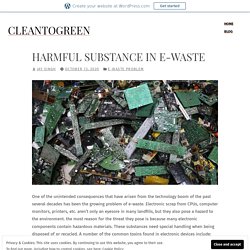
Electronic scrap from CPUs, computer monitors, printers, etc. aren’t only an eyesore in many landfills, but they also pose a hazard to the environment. the most reason for the threat they pose is because many electronic components contain hazardous materials. These substances need special handling when being disposed of or recycled. A number of the common toxins found in electronic devices include: Chromium: this is often a standard element in electronics thanks to its ability to stop corrosion and therefore the increased conductivity of electrical impulses. One sort of stuff, especially (Chromium IV) can damage the body’s DNA and irritate the mucous membranes. Human health safety in E-Waste – Cleantogreen.
Electronic waste affects nearly every system in the human body because the materials that makeup e-waste contain a plethora of toxic components, including mercury, lead, cadmium, polybrominated flame retardants, barium, and lithium.
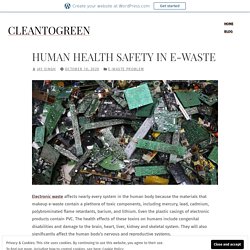
Even the plastic casings of electronic products contain PVC. The health effects of these toxins on humans include congenital disabilities and damage to the brain, heart, liver, kidney and skeletal system. They will also significantly affect the human body’s nervous and reproductive systems. E-Waste Management in India: Challenges and Opportunities – Cleantogreen. Growth within the IT and communication sectors has enhanced the usage of the equipment exponentially.
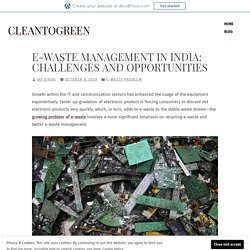
WHAT IS TECHNOLOGICAL WASTE? – Cleantogreen. Technological pollution, a 21st-century problemMobile phones, tablets, laptops: the proliferation of digital devices is becoming a drag for the earth because once they are available to the top of their useful lives — per annum, almost 50 million tons of technological scrap is generated — their recycling rate is low.

Improving it’s vital to slow global climate change and avoiding harm to the environment. How many mobile phones have you ever had in your life? The answer to the present question will offer you a thought of the impact that technological rubbish — or e-waste — has on the earth. According to MarketWatch, in 2018, consumers replaced their mobiles every 15 months. The Organisation for Economic Co-operation and Development (OECD) defines electronic waste as any device powered by electrical energy that has reached the end of its working life. TYPE OF E-Waste – Cleantogreen. Waste electrical and equipment (WEEE) is recycled more and more, and thanks to present legislation, the quantity of unusable e-waste is decreasing.E-waste includes:1.non-ferrous and precious metals,2.alloys,3.glass,4.ceramics,5.organic polymers with toxic content,6.other substances like stabilizers, fillers and pigments.

According to European legislation, producers are obliged to make sure the gathering of individual sorts of e-waste from customers.The collection applies to all or any sorts of household e-waste. Similarly, e-waste is collected from legal and natural persons. Electrical and equipment become waste after its delivery to a processor. TYPES OF ELECTRONIC WASTEHow many mobile phones have you ever had in your life? The answer to the present question will offer you a thought of the impact that technological rubbish — or e-waste — has on the earth.
According to a UN report, the planet generated 48.5 million plenty of electronic waste in 2018. Like this: Like Loading... Impact of E-Waste – Cleantogreen. Impacts On Human Health The complex composition and improper handling of e-waste adversely affect human health.
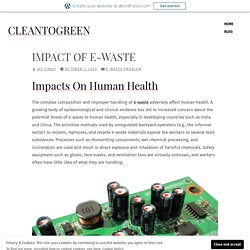
A growing body of epidemiological and clinical evidence has led to increased concern about the potential threat of e-waste to human health, especially in developing countries such as India and China. The primitive methods used by unregulated backyard operators (e.g., the informal sector) to reclaim, reprocess, and recycle e-waste materials expose the workers to several toxic substances. Processes such as dismantling components, wet chemical processing, and incineration are used and result in direct exposure and inhalation of harmful chemicals. Safety equipment such as gloves, face masks, and ventilation fans are virtually unknown, and workers often have little idea of what they are handling. For instance, in terms of health hazards, open burning of printed wiring boards increases the concentration of dioxins in the surrounding areas. Environmental Impacts Like this: The World Has an E-Waste Problem – Cleantogreen.
As a tech-hungry nation flush with cash gets able to upgrade to the subsequent generation of lightning-fast 5G devices, there’s a surprising environmental cost to be reckoned with: a fresh mountain of obsolete gadgets.

About 6 million lb. of discarded electronics are already processed monthly at recycling giant ERI’s Fresno plant. Pallets of once-beloved but now outdated devices, like smartphones with only an 8-megapixel camera or tablets with a mere 12 GB of storage, arrive here daily. Workers with hammers hack at the bulkiest devices, while others remove dangerous components like lithium-ion batteries. The scene is a twisted Pixar movie, with doomed gadgets riding an unrelenting conveyer belt into a machine that shreds them into piles of copper, aluminium and steel. “In our society, we always need to have the new, best product,” said Aaron Blum, the co-founder and chief operating officer of ERI, on a tour of the power. Electric Cars. Hire Professional SEO Expert. Social Media Optimization (SMO) What is SMO?
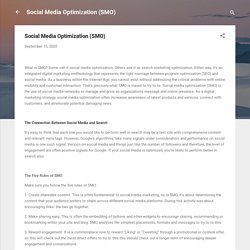
Some call it social media optimization. Others ask it as search marketing optimization. Either way, it's an integrated digital marketing methodology that represents the right marriage between program optimization (SEO) and social media. As a business within the Internet Age, you cannot exist without addressing the critical problems with online visibility and customer interaction. That's precisely what SMO is meant to try to to. The Connection Between Social Media and Search It's easy to think that each one you would like to perform well in search may be a fast site with comprehensive content and relevant meta tags.
The Five Rules of SMO Make sure you follow the five rules of SMO: